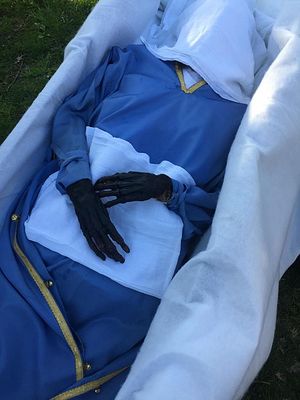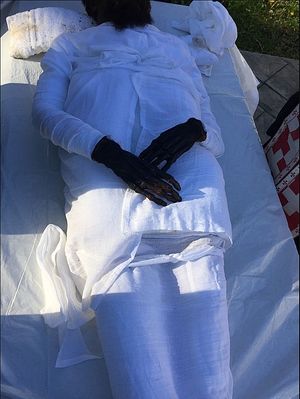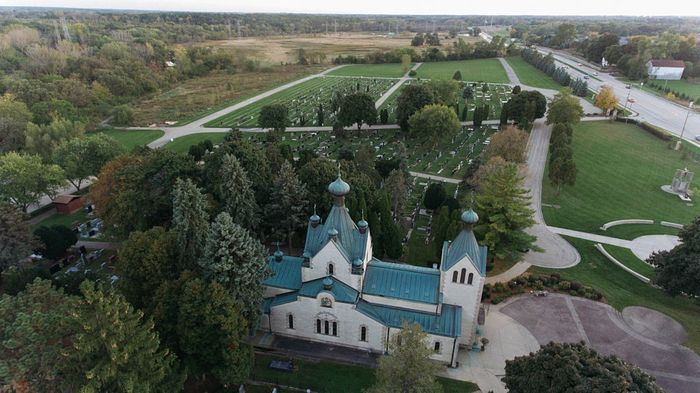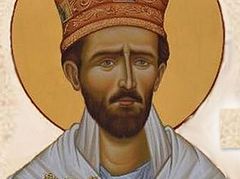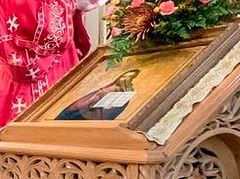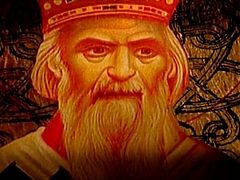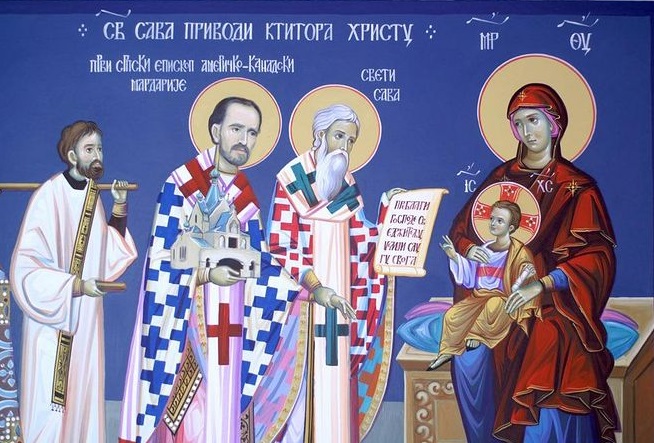 St. Mardarije, being led by the hand by St. Sava to offer the monastery in Libertyville to the Lord. Photo: miloje.org
St. Mardarije, being led by the hand by St. Sava to offer the monastery in Libertyville to the Lord. Photo: miloje.org At the May 29, 2015 session of the Holy Synod of the Serbian Orthodox Church, the names of Archimandrite Sebastian (Dabovich) and Bishop Mardarije (Uskokovic), clergymen and preachers of the Gospel, God-pleasing servants of holy life, and inspirers of many missionaries, were added to the calendar of saints of the Orthodox Church.
The annual commemorations of St. Mardarije of Libertyville, Bishop of America and Canada, and St. Sebastian of San Francisco and Jackson are observed on November 29/December 12 and November 17/30 respectively.
The glorification celebration of St. Sebastian occurred on Saturday, September 5, 2015 at St. Stephen's Serbian Orthodox Cathedral, Alhambra, California. Now the Serbian Orthodox Diocese of New Gracanica and Midwestern America invites all to participate in the Pan-Orthodox glorification of St. Mardarije of Libertyville and All-America, to be celebrated at St. Sava Serbian Orthodox Monastery in Libertyville, IL, from Friday July 14-Sunday July 16, by His Holiness Patriarch Irinej of Serbia.
In preparation for his glorification ceremony, St. Mardarije’s relics were recently opened and found to be incorrupt from the knees up, with skin and hair still intact, bearing witness to the sanctity of this holy God-pleaser, already confirmed by his inclusion among the ranks of the saints. St. Mardarije joins the ranks of St. John Maximovitch and St. Alexis Toth, whose incorrupt relics are already treasures for Orthodox Christians in America.
Life of St. Mardarije
St. Mardarije was born Ivan Uskokovic in Podgoritsa, Montenegro, in 1889. In 1907, he embraced monasticism at the Studenitsa Monastery and then relocated to Russia to study at the St. Petersburg Theological Academy. After graduation, he was ordained by the Russian Orthodox Church and sent as a missionary to America. In 1919, he was one of five Serbian Orthodox priests who participated in the Second All-American Sobor, held in Cleveland, Ohio in February 1919, at which time it was recommended that the Serbian Church in Belgrade advance him to the episcopacy to organize a Serbian Orthodox Diocese in America. Unfortunately, at this most chaotic time in the history of the Russian Orthodox Church, it was impossible to secure the written blessing of Patriarch (now Saint) Tikhon of Moscow. Later in 1919, Archimandrite Mardarije returned to Belgrade, where he was assigned as head of the Rakovitsa Monastery and principal of its monastic school. Subsequently, Bishop (now Saint) Nikolai (Velimirovic) of Ohrid was sent by Patriarch Dimitriye to administer the fledgling diocese. Having likewise returned to America, Archimandrite Mardarije served as St. Nikolai’s deputy for two years, and continued to administer the diocese after the latter’s return to Belgrade.
On April 26, 1926, Archimandrite Mardarije was consecrated to the episcopacy in Belgrade. Prior to his episcopal consecration, he had carried out most of the actual work of organizing the Serbian diocese. He also served as parish priest in Chicago and purchased with his personal funds the land for St. Sava Monastery in suburban Libertyville.
From the moment of his return to America, Bishop Mardarije undertook a wide range of ministries. He did not spare himself, nor did he fear work, although he knew that he was gravely ill with an advancing case of tuberculosis. In 1927, he convened the first National Church Assembly of the Serbian Orthodox American-Canadian Diocese to address a variety of organizational issues. At a clergy conference held in Youngstown, OH in 1931, he renewed his appeal for all to work for the unity and good of the diocese. His kindness, patience and reluctance to use punitive measures resulted in a great measure of unity within the diocese by the time of his repose on December 12, 1935 at the age of 46 years. He was interred at Libertyville’s St. Sava Monastery.
The Orthodox Church in America
The Opening of the Relics of Our Father Among the Saints Mardarije
First Serbian Bishop of America and Canada
April 22/May 5, 2017
With the blessing of His Grace, Bishop Longin of New Gracanica and Midwestern America, the relics of St. Mardarije, which have laid in the Church of St. Sava Monastery in Libertyville, Illinois, since his internment in December 1935, were uncovered. The opening revealed St. Mardarije’s holy relics to be incorrupt.
On Thursday, May 4, 2017, His Grace Bishop Longin served Divine Liturgy at St. Sava Monastery with Sindjel Serafim (Milojkovic), Priest Nikolaj Kostur and Hierodeacon Nektarije (Tesanovic), in preparation for uncovering the relics. Following the Divine Liturgy, Bishop Longin and the other clergy served a Moleban with the Akathist written to St. Mardarije. Upon completion, the crew organized to remove the tombstone and flooring in order to exhume the relics arrived, under the guidance of Mr. Dusan Djordjevic of Sveta Gora Funeral Home in Chicago. After removal of the stone, it was revealed that the casket of St. Mardarije was in a cement vault. This caused the opening to be delayed one additional day in order to organize a team to open the vault.
On Friday morning, May 5, 2017, the workers broke the seal of the vault, while Priest Nikolaj Kostur and Heirodeacon Nektarije (Tesanovic) served a Moleban to St. Mardarije at the tomb in the presence of Bishop Longin and Hieromonk Serafim (Milojkovic). Throughout the entire process of exhumation, “Christ is Risen” and other Paschal hymns were sung, both in Serbian and Russian tones, knowing St. Mardarije’s deep love and dedication to both Slavic traditions.
Once the seal of the vault was broken, every effort was taken to lift the cover. During this process, the cover of the vault shifted and fell on the casket, breaking its cover. At this moment, a sweet smelling fragrance arose from the tomb, quickly dissipating. However, it became evident that the Saint was buried facing the west instead of east. This in and of itself is miraculous. It manifested the Providence of God. Had St. Mardarije been buried in the proper direction, the vault cover would have fallen on the side of the casket where his holy head rested. It was visible that his feet had decayed and were bones.
Frs. Serafim and Nikolaj lifted the relics out of the tomb during the singing of “Christ is Risen.” The relics were light in weight and easily placed in a temporary metal coffin. Hereupon the feet were examined, which at this point were the only visible part of the remains. The bones of the feet were goldish-yellow in color. Then, Fr. Nikolaj Kostur proceeded to examine the mid-section of the body. St. Mardarije's Holy hands were holding the cross which was firmly in place and immovable. As Fr. Nikolaj pulled back the sleeve of the saccos, it was revealed that the hands of St. Mardarije were completely intact. Clearly visible were his skin, fingernails and hair. At this point, it was evident that the relics were more than just bones.
The holy relics of St. Mardarije were lifted out of the metal coffin and placed on two tables which were prepared for the examination and washing of the holy relics. All of the vestments and clothing were carefully removed, cutting that which could not easily be taken off in order to not disturb the holy relics. Most reverent and diligent care and utmost attention were given to the work that was being done; the clergy continuously sang the troparion to St. Mardarije and other Paschal hymns.
After all the vestments were removed, it was revealed that the holy relics, from the knee upward, were intact, although very fragile. The Saint’s anatomy was intact with his skin and hair visible. When the mitre was removed, his long, dark hair flowed out, confirming his continued monastic struggle until the end of his days. The hair on his head and beard looked as though he had just reposed; it was very soft. The eyebrows and eyelashes of his closed eyes were visible. Also, his ears were still intact. The body was easily lifted and moved. There was a great deal of dust which had accumulated in the grave from the nearly eighty-two years since the burial. Upon the removal of the dust from the entire body, the holy relics were washed with warm water and white wine. Hereupon spikenard oil was was used to anoint the body, according to the instructions received from the Holy Monastery of Hilandar. After the anoninting, the color of the skin changed from tan to a dark brown.
After the washing and anointing, the legs, hands and torso were all wrapped in cotton and linen, making the holy relics more easily movable. Following this process, the holy relics were temporarily vested in a stiharion until his vesting takes place before his Glorification in July 2017. His face was covered with linen, and he was returned to the temporary metal coffin and covered.
Truly, God is wondrous in His Saints, showing us all His Divine power and that nature is subject to God’s grace. All of those that partook in this experience, from the clergy to the workers, were moved with the joy and spiritual peace that filled the church during the uncovering of the holy relics. St. Mardarije lives on, not only in his legacy, but now through his incorrupt relics which will be a renewed rudder for the Serbian Orthodox Church in North and South America, guiding us to move into the future, being directed by the past. May we follow St. Mardarije on the path of St. Sava, which led him to sanctity.
Our Holy Hierarch, Father Mardarije, pray unto God for us! Christ is risen!
Priest Nikolaj Kostur
Chairman of the Liturgical Sub-Committee for the Glorification of St. Mardarije
The Serbian Orthodox Church in North and South America
St. Sava Monastery in Libertyville, Illinois
St. Mardarije’s incorrupt relics are kept in the church at St. Sava’s Monastery in Libertyville, IL, which was built with great contribution from the saint himself, and consecrated on September 6, 1931.
The erection of the monastery had the support of many early leaders of Orthodoxy in America. In a 1910 letter to Serbian patriarch Lukian, St. Karamata the Serb, who had lived in America, suggested purchasing land for a Serbian center in America for a monastery and diocesan center. St. Nikolai Velimirovic also suggested to the Holy Synod to build a monastery to serve as a religious center, summer camp, and refuge for the sick and the elderly. On September 14, 1922, Hieromonk Pavle (Markovich) petitioned Russian Metropolitan Platon to bless the establishment of a Serbian Monastery.
After the establishment of the Serbian diocese, St. Nikolai asked St. Mardarije to buy property near Chicago for a monastery, seminary, and printing shop, to serve as the center of Serbian religious life. He began a fundraising campaign which was met with approval by the Serbian patriarch and Holy Synod, and also contributed physical labor once building of the monastery commenced. One prominent Serb stated, “When we arrived to the property we were all surprised. Instead of finding the bishop resting we saw him in the midst of twelve to fifteen workers supervising and helping the workers to speed and beautify this new church structure. He wanted to see every stone laid in the wall with the explanation, This is built for eternity for my people.” He was also often seen carrying and placing large stones himself, to save expenses.
Construction on the monastery stalled in 1927 due to a lack of funds and internal strife within the diocese which was lacking a bishop. The Holy Synod of the Serbian Church elected Archimandrite Mardarije and consecrated him as bishop on April 15, 1926. The new bishop arrived in New York on April 25, 1926. The following year he transferred the Libertyville property from his name to the Serbian Orthodox Church and the local diocese, but the financial situation remained grim until the great Serbian scientist and professor of Columbia University Mihaila Pupin donated $30,000, thus bringing an end to the financial crisis.
The monastery was built in the typical Russian Novgorod architectural style, with twelve small domes and a large one in the center. More than five thousand people attended the September 6, 1931 consecration of the monastery, which St. Mardarije termed a moral success.
After having labored for several years to found the monastery and stabilize the Serbian diocese, St. Mardarije reposed in the Lord from illness on December 12, 1935, and was interred at the monastery he built through his own labors and prayers.
St. Mardarije wrote in his last will and testament:
I bequeath to my dear Serbian people this holy monastery as a gathering place of Serbs in America and a common house of prayer, to be forever the house of God, that, after my death, they may preserve and cherish it, and hand it down as a splendid memorial of their ethnic and religious spirit to their Serbian offspring in this new world in order that they know forever that there were Serbs on this side of the Atlantic, far from the homeland…
I recommend and leave as my last will that this holy St. Sava Serbian Orthodox Monastery in Libertyville be the see of my successor. Also that he loves the monastery as I did, nourishes it as I nourished it and with my own hands every tree planted …
Having premonition of my departure from this world I entrust my dear faithful, my dear Serbian people in America to the protection of the Almighty God. All I ask from my people when in the monastery, is to light a candle at my graveside and to say a prayer for the repose of my soul. I will pray for all of you even after my death. Good bye.
The monastery church was later renovated in 1941, and again in 1979. A children’s camp was established in 1946, and the St. Sava Seminary in 1945. The monastery’s famous cemetery dates to the 1930s.
Monastery history compiled from information on the site of St. Sava Orthodox Monastery
Troparion of Sts. Mardarije and Sebastian, Tone 8:
O God of our Fathers,
Always act with kindness towards us;
Take not Your mercy from us,
But through the prayers of Saints Mardarije
and Sebastian
Guide our lives in peace.
Kontakion to St. Mardarije of Libertyville, Tone 8:
Tireless preacher of Christ the Lord,
Leader on the path of St. Sava for your people in diaspora,
Labor-loving practitioner and teacher of repentance,
Holy Mardarije of Libertyville and America,
Together with all the Enlighteners of the
American lands,
Entreat the only Lover of Mankind,
To grant all Orthodox Christians peace and unity!


